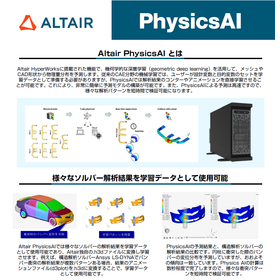Supports low loss and high efficiency of EV motors! Capable of analyzing rotating magnetic fields and hysteresis.
"μ-E&S" is a loss analysis software that can simulate the distribution of magnetic flux density, magnetic field, and iron loss based on actual measurements of motor laminated iron cores. By analyzing vector magnetic characteristics, it can identify areas where iron loss occurs significantly, making it a useful tool for the miniaturization, lightweighting, low loss, and high efficiency of motors. 【Features】 ■ High-precision calculation of magnetic vectors ■ Capable of calculating rotating magnetic fields and hysteresis ■ Equipped with permanent magnet excitation function and torque calculation function *For more details, please refer to the materials. Feel free to contact us with any inquiries.
Inquire About This Product
basic information
For more details, please contact us or download the catalog.
Price range
P5
Delivery Time
Applications/Examples of results
*For more details, please refer to the materials. Feel free to contact us as well.*
Detailed information
-

Maximum magnetic flux density Maximum magnetic flux density distribution of IPM motors: The lack of variation in the circumferential direction is the same result as in conventional methods.
-

Maximum magnetic field strength Distribution of maximum magnetic field strength in IPM motors: The rolling direction is along the X-axis, and anisotropy is calculated even for non-oriented electrical steel sheets, resulting in high regions appearing in the upper and lower areas. This is a result that cannot be calculated using conventional methods.
-

Iron loss distribution Iron loss distribution of the IPM motor: Using the calculated results of H and B, hysteresis curves are drawn for each element, and the total area is used to calculate the iron loss distribution. Since the magnetic field strength was high in the upper and lower regions, high portions of iron loss were also calculated in these areas. This is a result that cannot be obtained by conventional methods.
-

Hysteresis curve The magnetic flux density vector and magnetic field strength vector for each element have been obtained as calculation results, so the hysteresis curve is simply formed by connecting them over one electrical angle cycle. There is no need to use algorithms such as hysteresis models.
-

Rotating magnetic flux / rotating magnetic field Lissajous waveform: The Lissajous waveform is the trajectory of the magnetic flux density vector and the magnetic field strength vector. The difference in the direction of each vector (spatial phase difference) is also obtained as a calculation result.
-

Maximum magnetic flux density Transformers are made up of oriented electrical steel sheets.
-

Maximum magnetic field strength In the T-shaped joint, the magnetization easy direction is shifted by 90 degrees, resulting in a region with high magnetic field strength.
-

Iron loss distribution The magnetic flux density is high inside the transformer window, which leads to a large iron loss, but the reason for the significant iron loss at the T-shaped coupling section is due to the high magnetic field strength. This is a result that cannot be obtained by conventional methods.
-

Rotating magnetic flux and rotating magnetic field. In the T-shaped joint, the rotating magnetic flux is significantly present. Additionally, the transformer leg is a location where alternating magnetic flux occurs along the direction of magnetic charge ease, but a small rotating magnetic field can be observed. This is a result not achievable by conventional methods.
catalog(12)
Download All CatalogsNews about this product(28)
Company information
With a motto of 'swift response and provision of cutting-edge technology,' our experienced technical staff directly provides services aligned with the company's timeline. We aim to contribute to researchers and engineers in the R&D and design departments by incorporating the latest technologies, which are gaining attention at academic societies such as the Institute of Electrical Engineers, into our software, and by continuously disseminating state-of-the-art tools and information. ■ For customers who are not experts in analysis μ-EXCEL is an easy and fast analysis software for initial assessments. The concept is to simplify operations as much as possible and quickly produce results to first determine the validity of ideas. Additionally, we offer a subscription service that lowers the barrier to entry. For a monthly fee of 9,800 yen, users can access unlimited use, with options for monthly subscriptions only when needed, and the ability to resume at any time. As part of our comprehensive support system, "Analysis Know-How.com" was created. It compiles an overview of analysis tasks and techniques into short videos. Users can efficiently search during their spare time on their smartphones. If you still have questions, please send your Excel file as an email attachment, and our experienced supporters will review it and provide answers. ■ For customers who want to delve even deeper We are expanding our business into specialized themes.


![Iron Loss Analysis Tool [μ-E&S] Materials](https://image.mono.ipros.com/public/catalog/image/01/b06/402378/IPROS51362207603783976192.jpeg?w=120&h=170)



















![[Case Study] Examination of the Arrangement of Heat Resistance Elements through Inverse Analysis](https://image.mono.ipros.com/public/product/image/e20/2000557020/IPROS57856363781651891432.png?w=280&h=280)




